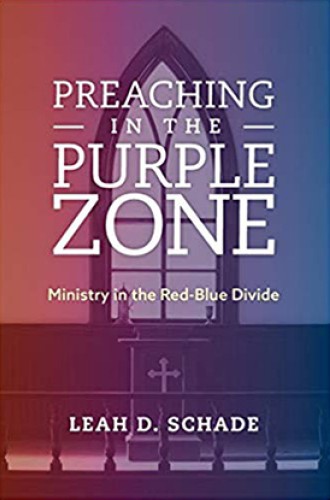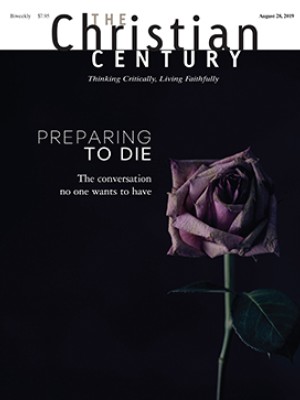In a politically divided church, what’s the preacher to do?
The answer, says Leah Schade, is about dialogue as much as any single sermon.
Megan Rapinoe, in her now famous speech in New York after her team won the World Cup, issued this call to action: “This is my charge to everyone. We have to be better. We have to love more, hate less. We got to listen more, and talk less. . . . There’s been so much contention in these last years. I’ve been a victim of that. I’ve been a perpetrator of that . . . but it’s time to come together.” The following week, Donald Trump initiated a national feud with a series of racist tweets in which he told congresswomen they should go back to their home countries.
This is the nation we live in; this is the tenor of our discourse. Clearly, preachers do indeed need resources for “ministry in the red-blue divide.”
Enter Leah Schade. Her first book, Creation-Crisis Preaching: Ecology, Theology, and the Pulpit, positioned her as one who is familiar with purple preaching. Preaching on climate change means wading directly into the purple zone.
Although the title of her latest book focuses on preaching in the purple zone—implying that the focus would be on getting beyond partisan politics—the real center of her work is examining a more dialogical approach to preaching itself.
Many readers of this magazine are likely familiar with the inductive approach to preaching popularized by authors like Fred Craddock and Barbara Brown Taylor. Inductive preaching is designed to bring listeners along on the journey of discovery that the preacher has been on as she has engaged with the biblical text. Schade points out that this inductive method—sometimes called the New Homiletic—still privileges the preacher’s insights over that of the assembly.
Read our latest issue or browse back issues.
Schade introduces an alternative model, rooted in the concept of conversational preaching. She introduces a sermon-dialogue-sermon method, providing case studies, model sermons, and even an appendix of resources to announce and support the deliberative dialogue she proposes.
In the simplest form of this approach, the preacher first preaches a prophetic invitation to dialogue. Rather than simply launching into antagonistic propheticism, which Schade believes typically fails to get the response desired, the preacher begins by opening space for dialogue on a difficult topic. This sermon has a series of prescribed steps: point out the dialogical aspects of a specific biblical text; determine what’s at stake; identify the values; explain how God, Jesus, and Holy Spirit are active; recognize what the dialogue is teaching; and suggest possible next steps.
After this first sermon, the congregation schedules a deliberative dialogue. This session, anywhere from 90 minutes to a few hours in length, also has a specific structure: introduce the topic, establish ground rules, share how this issue impacts you personally, evaluate the pros and cons of possible approaches to complex problems (recognizing that there’s often a third option), reflect on these options to identify common themes and shared values, and suggest and discuss next steps for taking action.
The preacher, having participated in this deliberative dialogue with the community, then returns to the pulpit the following Sunday to preach a second sermon. This sermon draws on the process of dialogue that has taken place—and presumably is continuing to take place—in the community. The second sermon may be prophetic in the sense that it expresses “unrelenting hope about God’s activity to transform church and society in a present-future sense based on the principle of justice.” The sermon-dialogue-sermon model makes use of the preacher’s “unique position and opportunity to model a dialogical approach to a contentious issue while also examining it through the lens of the gospel.”
Schade was inspired to develop this model for preaching after she conducted a 1,200-person survey of clergy. Her research led her to conclude that many pastors do not feel trained or prepared to preach in the purple zone. They simply avoid controversial issues altogether, both because of the inherent risks involved and because many doubt whether it would make a difference in the life of their congregation.
There are many strengths to Schade’s proposal, not least its unerring commitment to bringing the whole people of God more fully into the preaching task.
Nevertheless, it does raise the participation bar significantly. Given that most congregations are not regularly in the habit of gathering midweek to discuss contentious issues, one might wonder how realistic the proposal is.
Then again, all calls to unity raise the bar. When we hear calls like Rapinoe’s to come together, take responsibility, listen more, and be better, we are likely to respond by asking, “How?” Schade meticulously lays out the details of the how, puts them into practice, and offers examples of how it all works.
Schade has given us a clear path toward loving more and hating less, not by avoiding life in the purple zone but by directly engaging it.







